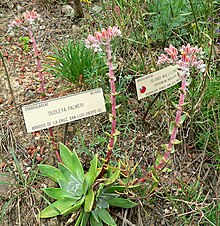
Dudleya abramsiisubsp. setchellii, known by common name as the Santa Clara Valley dudleya or Santa Clara Valley liveforever, is a member of the Dudleya genus of succulent perennials, members of the family Crassulaceae. The Santa Clara Valley dudleya, endemic to the Santa Clara Valley region in the southern San Francisco Bay Area, was listed on 3 February 1995, as an endangered species. It is considered to be a subspecies of Dudleya abramsii, but its taxonomic status is still unclear. Its closest relative is Dudleya cymosa subsp. paniculata, which is a morphologically similar sister taxon.

Dudleya caespitosa is a succulent plant known by several common names, including sea lettuce, sand lettuce, and coast dudleya. It is endemic to California, where it grows along the coastline in the southern half of the state. Taxonomically, this species is a highly variable complex of polymorphic and polyploid plants, closely related to numerous neighboring species such as Dudleya farinosa, Dudleya greenei and Dudleya palmeri. It is delimited from neighboring species on an arbitrary basis of distribution and chromosome number, and may not be immediately separable from the other species it approaches.

Dudleya candelabrum is a species of succulent plant known by the common names candleholder liveforever or candleholder dudleya. Endemic to California, this species grows wild only on the northern Channel Islands, where it is found in open rocky places and north-facing slopes. It is characterized by thin, spade-shaped green leaves and an inflorescence covered in long, reflexed bracts, with pale yellow flowers. It has been threatened by poachers shipping plants to South Korea.

Dudleya farinosa is a species of succulent plant in the family Crassulaceae known by several common names, including bluff lettuce, powdery liveforever, and powdery dudleya. A coastal plant of northern California and southern Oregon, it is typically found on oceanic bluffs just directly above the reach of the waves. Its appearance is characterized by lotus-like rosettes of beveled leaves, and in summer the plant erects a tall pink to red stem densely covered in foliage, topped with branches adorned with pale yellow flowers. The green or white rosettes of this plant can be seen covering stretches of rocky coast and nearby islets.

Dudleya lanceolata is a succulent plant known by the common name lanceleaf liveforever or lance-leaved dudleya. It is an extremely variable and widely ranging species that occurs from Monterey County and Kern County in California south through Ensenada in Baja California. It is characterized by green to purple lanceolate leaves, red, orange, or less commonly yellow petals, and is typically tetraploid. Despite its diversity, it is quite stable as a species, but hybrids may be discovered with other species of Dudleya, which can make it difficult to discern in areas where numerous species converge.
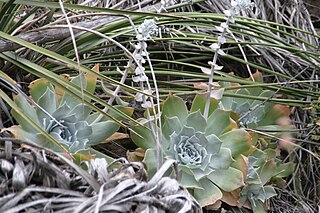
Dudleya pulverulenta is a species of perennial succulent plant known by the common names chalk lettuce, chalk dudleya, and chalk liveforever. It is one of the largest Dudleya, with a silvery, waxy rosette that may greatly contrast with its habitat. It is also regarded as one of the most distinctive members of the Dudleya, with the most advanced inflorescence in the genus, consisting of pendant, hummingbird pollinated flowers, the longest corolla, and the highest nectar output, along with the largest range of all the Dudleya, over 1,000 kilometres (620 mi), being found from southern Monterey County in California to the Sierra de San Borja in southern Baja California.

Dudleya stolonifera is a succulent plant known by the common name Laguna Beach liveforever or Laguna Beach dudleya. This is a rare plant which is endemic to the coastline of Orange County, California. It is known from only about six populations in the vicinity of Laguna Beach, totaling about 30,000 individuals. It is federally listed as a threatened species of the United States.

Dudleya greenei is a perennial species of succulent plant known by the common names Greene's liveforever, or Greene's dudleya. It is endemic to the Channel Islands of California, where it grows along the cliffs of four of the eight islands. It is a highly variable plant, presenting with multiple forms and varying levels of ploidy. Taxonomically, this species is an insular segregate of Dudleya caespitosa, and was placed as a stopgap taxon by Reid Moran in his 1951 thesis on the genus. It is characterized by white or green leaf rosettes, loomed over by inflorescences bearing pale yellow to white flowers. It is a member of the subgenus Dudleya, as it cannot be propagated from leaf cuttings, does not grow from a corm, and has tight petals.

Dudleya variegata is a deciduous succulent plant in the family Crassulaceae known by the common names variegated liveforever, variegated dudleya or rarely San Diego Hasseanthus. A cryptic plant that survives part of the year dormant underground from starch reserves in a corm, after sufficient rainfall, leaves will emerge, soon giving way to small inflorescences with yellow star-shaped flowers. It is native to Baja California and adjacent San Diego County in California, where it grows in several habitat types, including chaparral and vernal pools.
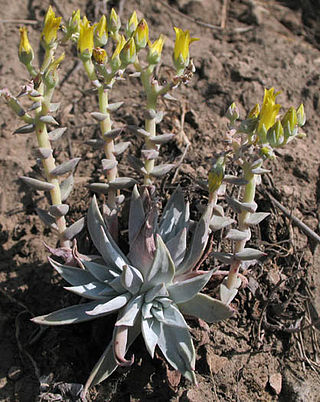
Dudleya verityi is a rare species of succulent plant known by the common name Verity's liveforever. It is endemic to Ventura County, California, where it is known from only three occurrences in the vicinity of Conejo Mountain between Camarillo and Thousand Oaks. It probably occurs in a few additional locations nearby which have not yet been officially vouchered.

Dudleya attenuata is a species of perennial succulent plant known by the common name taper-tip liveforever, native to Baja California and a small portion of California. A rosette-forming leaf succulent, it has narrow pencil shaped leaves that can often be found covered in a white epicuticular wax. The thin, sprawling stems branch to form the clusters of rosettes, with plants creating a "clump" up to 40 cm wide. The small flowers are white or yellow, with 5 spreading petals. It is a diverse, variable species that extends from the southernmost coast of San Diego County to an area slightly north of the Vizcaino Desert, hybridizing with many other species of Dudleya in its range. Some plants with white or pinkish flowers were referred to as Orcutt's liveforever, referring to a former subspecies split on the basis of the flower color.

Dudleya anomala is a rare species of succulent plant in the family Crassulaceae commonly known as the Todos Santos liveforever. With a dense, cushion-forming habit, this leaf succulent is characterized by elongated stems, slightly sticky leaves, and bell-shaped flowers with white, spreading petals. This species is native to Baja California, Mexico, and is found primarily on islands and one coastal locality.
Dudleya formosa, known by the common name La Misión liveforever, is a species of perennial succulent plant endemic to the Guadalupe Valley in Baja California. It is characterized by bright green leaves, red floral stems, and pink flowers.

Dudleya cymosa subsp. paniculata, known by the common name Diablo Range dudleya, is a species of perennial succulent plant in the family Crassulaceae native to the Inner South Coast Range of California. It is characterized by pale yellowish flowers, oblong to oblanceolate leaves and a growth habit not limited to a single substrate. It is closely related to Dudleya abramsii subsp. setchellii.
Dudleya cymosasubsp. costatifolia, known commonly as the Pierpoint Springs dudleya or the Pierpoint Springs liveforever, is a species of succulent plant in the family Crassulaceae, narrowly endemic to a locality in Tulare County, California, United States. It is a clumping plant with small rosettes and bright yellow flowers, resembling alpine cushion plants.
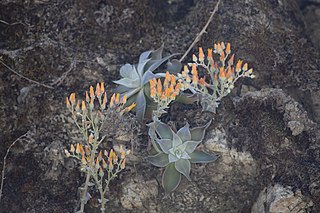
Dudleya cymosasubsp. pumila, most commonly known as the low canyon dudleya, chalky canyon dudleya or California live-forever, is a species of perennial succulent plant. It has diamond to spoon shaped leaves, sometimes coated with a fine white powder, and in May through July, bright red, orange or yellow flowers adorn the short inflorescence. A leaf succulent primarily found growing in rocky cliffs and slopes, it is endemic to California, and grows in the Transverse Ranges and South Coast Ranges, with some outlying populations. A variable plant, in some localities it is difficult to distinguish from other plants in the genus.

Dudleya saxosasubsp. aloides is a species of perennial succulent plant in the family Crassulaceae known by the common names desert dudleya or desert savior. It is a rosette-forming species widely distributed throughout the Peninsular Ranges and desert mountains of California in the United States. It is characterized by bright-yellow or greenish-yellow flowers, and can be found in shaded crevices and slopes. Plants in western half of the range may grade into Dudleya lanceolata.

Dudleya cymosasubsp. cymosa is a species of succulent perennial plant in the family Crassulaceae native to California. It is the autonymous subspecies for Dudleya cymosa, and is known by the common name canyon liveforever. It is native to the California Coast Ranges, the Sierra Nevada and the Santa Monica Mountains. It is characterized by bright-yellow, orange or red flowers and broad, wide leaves. This plant is commonly found growing on rocky outcrops, talus slopes, and in shaded canyons.
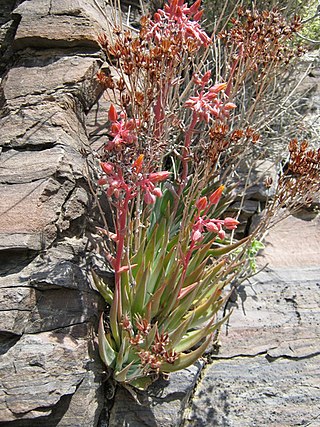
Dudleya saxosasubsp. saxosa is a species of succulent perennial plant endemic only to the western Panamint Range of California. It is known commonly as the Panamint liveforever or Panamint dudleya. It is found on north-facing, granitic or limestone slopes and grows up to 20 cm wide. It is characterized by bright yellow, red tinged flowers, which bloom from May to June.

Dudleya cymosasubsp. agourensis, commonly known as the Agoura Hills dudleya or Agoura Hills liveforever, is a species of perennial succulent plant. A rare and critically imperiled species from the Santa Monica Mountains in California, it is characterized by glaucous, gray-purple leaves, bright yellow flowers, and ascending bracts. A leaf succulent, it is found growing on west to northwest-facing open, rocky volcanic slopes.


